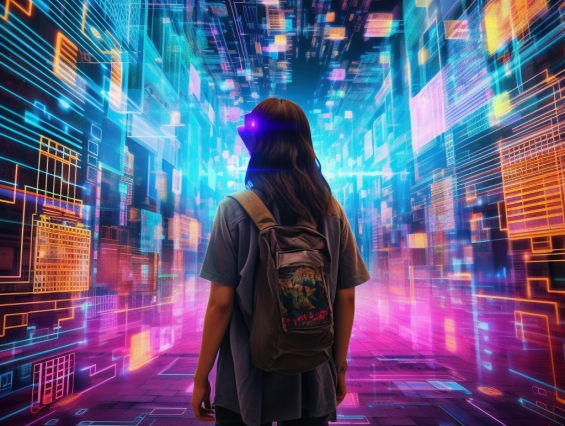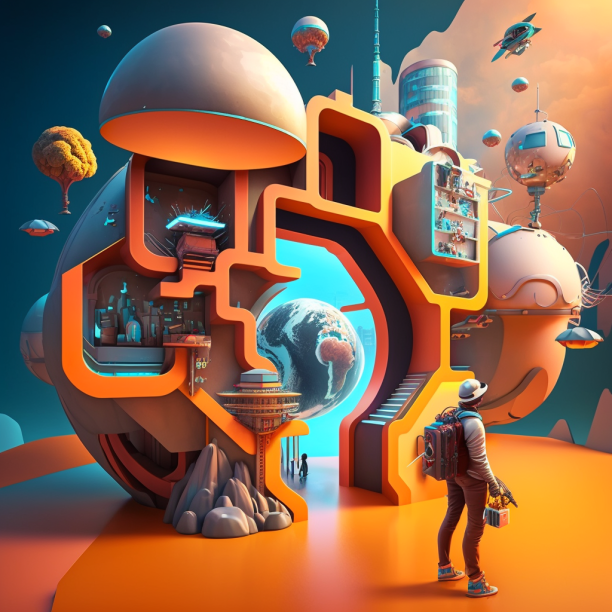
Are you ready to explore the future of virtual reality? This comprehensive guide explains what it is, how it works, and its potential impact on society. Learn about the technologies that will enable the metaverse, including virtual reality, augmented reality, blockchain, cloud computing, artificial intelligence, and computer vision.
The metaverse, a term coined by science fiction author Neal Stephenson in his 1992 novel Snow Crash, is rapidly becoming a reality. This interconnected digital universe promises to revolutionize the way we work, play, and interact with one another.
What is the Metaverse?
I is a shared, immersive virtual space where users can interact with a computer-generated environment and other users. It is a combination of virtual reality, augmented reality, and other immersive technologies that create a seamless experience across digital platforms. It is not a single product or platform, but a concept that encompasses a broad range of technologies and applications.
How Does it Work?
It works by connecting various virtual worlds, online communities, and social networks to create a shared experience. It is made possible by advanced computing technologies, such as blockchain and cloud computing, that allow for the creation and sharing of complex digital environments. Users can enter it using a variety of devices, including VR headsets, smartphones, and laptops.
One of the key features is its ability to create immersive experiences that mimic the physical world. Users can interact with virtual objects, navigate through digital spaces, and communicate with other users in real-time. It also allows for the creation and sharing of user-generated content, giving users the ability to shape and customize their virtual environments.

Potential Impact
The metaverse has the potential to transform a wide range of industries, from gaming and entertainment to education and healthcare. Here are just a few examples of how could be used in the future:
- Gaming and Entertainment: It could revolutionize the gaming industry by creating more immersive and interactive gaming experiences. Players could enter a virtual world where they can compete in real-time with other players from around the world.
- Education and Training: Create immersive educational experiences, allowing students to learn through virtual simulations and interactive environments. It could also be used for professional training, such as virtual simulations for pilots and surgeons.
- Healthcare: Provide remote healthcare services, such as virtual consultations and remote monitoring. It could also be used for medical research, such as virtual simulations of diseases and drug interactions.
- Social Networking: A new way for people to connect and interact with one another, creating virtual communities that span the globe.

Challenges
The potential is truly limitless, and its impact on society is likely to be profound. However, there are also challenges and concerns associated with the development of it.
One of the biggest challenges is interoperability. As it evolves, it will be made up of a vast network of virtual worlds, platforms, and applications. Ensuring that these different systems can communicate and work together seamlessly will be a major technical challenge.
Another challenge is the issue of privacy and security. As with any digital platform, it will be vulnerable to cyber attacks, data breaches, and other security threats. Ensuring that users’ personal information and data are kept safe and secure will be critical to the success.
There are also concerns about the potential to exacerbate existing social and economic inequalities. For example, if access is restricted to those who can afford expensive hardware and high-speed internet connections, it could widen the digital divide between rich and poor.
Despite these challenges and concerns, the development of it is likely to continue at a rapid pace. Major technology companies like Facebook, Google, and Microsoft are already investing heavily in the development, and startups are emerging to create new platforms and applications.

Technologies for the Metaverse
The development will require the integration of a wide range of technologies, including virtual reality, augmented reality, blockchain, cloud computing, and artificial intelligence.
- Virtual reality (VR) is a critical technology, as it allows users to immerse themselves in digital environments and interact with virtual objects and other users. VR headsets like the Oculus Rift and HTC Vive have already made significant strides in creating immersive experiences, but there is still much work to be done to create a truly seamless and realistic virtual world.
- Augmented reality (AR) is another important technology, as it allows for the overlay of digital information on the physical world. This could be used to create augmented reality experiences that blend seamlessly with the real world, creating a hybrid reality that combines the best of both worlds.
- Blockchain technology is also crucial, as it allows for the creation and sharing of digital assets and transactions in a secure and decentralized way. This is particularly important for virtual economies, where users can buy and sell virtual goods and services using digital currencies like Bitcoin or Ethereum.
- Cloud computing is also critical, as it provides the computing power and storage needed to create and host complex digital environments. It will require vast amounts of computing power and storage to support the creation and sharing of user-generated content, as well as the hosting of virtual events and experiences.
- Computer vision is the ability of machines to interpret and understand visual information from the world around them. In the context of the metaverse, computer vision can be used to create more immersive and interactive virtual environments. For example, computer vision could be used to track users’ movements and gestures, allowing them to interact with virtual objects and other users in a more natural and intuitive way.
- Finally, artificial intelligence (AI) will play a crucial role, as it can be used to create more intelligent and interactive virtual environments. AI could be used to create virtual assistants, chatbots, and other intelligent agents that can help users navigate this new world and interact with other users in a more natural and seamless way.
In order to fully develop the metaverse, these technologies will need to be integrated and optimized to work together seamlessly. This will require significant research and development, as well as collaboration between technology companies, startups, and academic researchers.
Conclusion
In conclusion, the metaverse is a new and exciting frontier in the world of digital technology. Its ability to create immersive and interactive experiences has the potential to transform a wide range of industries and to shape the way we interact with one another in the digital world. However, the development also poses significant challenges and concerns, and it will be important to address these issues as it continues to evolve. The future of it is uncertain, but one thing is clear: it will be a fascinating journey to watch it unfold.